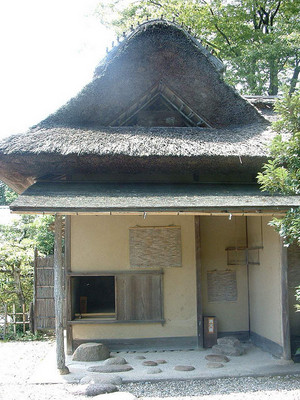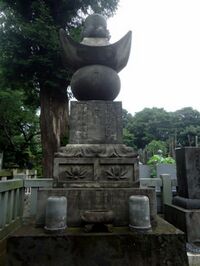Difference between revisions of "Matsudaira Fumai"
(Created page with "*''Born: 1751'' *''Died: 1818'' *''Japanese'': 松平不昧 ''(Matsudaira Fumai)'' Matsudaira Fumai was a ''daimyô'' of Matsue han, and famed tea master. He...") |
|||
| (3 intermediate revisions by the same user not shown) | |||
| Line 1: | Line 1: | ||
| + | [[File:Meimeian.jpg|right|thumb|300px|Teahouse designed by Fumai at [[Meimeian]] in Matsue]] | ||
| + | [[File:Matsudaira fumai-grave.JPG|right|thumb|200px|Fumai's grave at [[Gokoku-ji (Tokyo)|Gokoku-ji]] in Tokyo]] | ||
*''Born: [[1751]]'' | *''Born: [[1751]]'' | ||
| − | *''Died: [[1818]]'' | + | *''Died: [[1818]]/4/24'' |
| + | *''Childhood Name'': 鶴太郎 ''(Tsurutarou)'' | ||
| + | *''Other Names'': 治郷 ''(Harusato)'', 未央庵 ''(Miouan)'', 一々斎 ''(Ichiichisai)'', 宗納 ''(Sounou)'' | ||
*''Japanese'': [[松平]]不昧 ''(Matsudaira Fumai)'' | *''Japanese'': [[松平]]不昧 ''(Matsudaira Fumai)'' | ||
| − | Matsudaira Fumai was | + | Matsudaira Fumai was the seventh [[Matsudaira clan (Echizen)|Matsudaira clan]] ''daimyô'' of [[Matsue han]], and a famed tea master. |
| + | |||
| + | He took his pseudonym Fumai from a phrase "''furaku fumai''" which appears in the ''Mumonkan hyakujô yako''. | ||
| + | |||
| + | Fumai became lord of Matsue at age 17, and with the help of ''[[karo|karô]]'' [[Asahi Tanba]], enacted reforms to improve the domain's administration. He began practicing [[tea ceremony]] at the age of 20, and later began assembling a notable collection of tea implements. | ||
He compiled a guide to ''meibutsu gire'' (famous textiles associated with [[tea ceremony]]) published in [[1789]]-[[1797]], and was also involved in the rebuilding of the [[Kohoan]] at [[Daitoku-ji]], which had been destroyed by fire in [[1793]]. | He compiled a guide to ''meibutsu gire'' (famous textiles associated with [[tea ceremony]]) published in [[1789]]-[[1797]], and was also involved in the rebuilding of the [[Kohoan]] at [[Daitoku-ji]], which had been destroyed by fire in [[1793]]. | ||
| + | |||
| + | Fumai's daughter [[Ikusen]] was the second wife of [[Hotta Masachika]], and is buried alongside members of the [[Hotta clan]] at [[Jindai-ji]] in [[Sakura (city)|Sakura]], [[Chiba prefecture]]. | ||
{{stub}} | {{stub}} | ||
| Line 11: | Line 21: | ||
==References== | ==References== | ||
*"Albums of Ancient Textiles," Gallery label at [[Tokyo National Museum]], August 2013. | *"Albums of Ancient Textiles," Gallery label at [[Tokyo National Museum]], August 2013. | ||
| + | *Pamphlet from Meimeian tearoom, Matsue. | ||
[[Category:Samurai]] | [[Category:Samurai]] | ||
[[Category:Artists and Artisans]] | [[Category:Artists and Artisans]] | ||
[[Category:Edo Period]] | [[Category:Edo Period]] | ||
Latest revision as of 21:22, 7 July 2015


- Born: 1751
- Died: 1818/4/24
- Childhood Name: 鶴太郎 (Tsurutarou)
- Other Names: 治郷 (Harusato), 未央庵 (Miouan), 一々斎 (Ichiichisai), 宗納 (Sounou)
- Japanese: 松平不昧 (Matsudaira Fumai)
Matsudaira Fumai was the seventh Matsudaira clan daimyô of Matsue han, and a famed tea master.
He took his pseudonym Fumai from a phrase "furaku fumai" which appears in the Mumonkan hyakujô yako.
Fumai became lord of Matsue at age 17, and with the help of karô Asahi Tanba, enacted reforms to improve the domain's administration. He began practicing tea ceremony at the age of 20, and later began assembling a notable collection of tea implements.
He compiled a guide to meibutsu gire (famous textiles associated with tea ceremony) published in 1789-1797, and was also involved in the rebuilding of the Kohoan at Daitoku-ji, which had been destroyed by fire in 1793.
Fumai's daughter Ikusen was the second wife of Hotta Masachika, and is buried alongside members of the Hotta clan at Jindai-ji in Sakura, Chiba prefecture.
References
- "Albums of Ancient Textiles," Gallery label at Tokyo National Museum, August 2013.
- Pamphlet from Meimeian tearoom, Matsue.